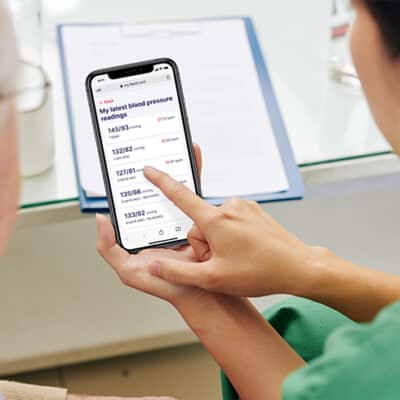In today’s digital age, remote patient monitoring (RPM) has emerged as a game-changer in healthcare by enabling providers to remotely monitor their patients’ health conditions. A wide range of clinical evidence has demonstrated the benefits of RPM, from improving patient outcomes to expanding access to care.
RPM has also been shown to increase patient engagement and empower patients to be more active participants in their healthcare journey. With the support of digital devices, such as glucose monitors, blood pressure cuffs, pulse oximeters and weight scales, patients can continuously track their vital signs while gaining insights into their health that help foster a stronger sense of responsibility for their wellness. With RPM, not only are patients often more adherent to their care plan, but there are more opportunities for engagement and improved patient-provider communication.
As the first RPM provider to implement a patient-centric platform, including an AI virtual health assistant and easy-to-use devices, patient engagement has always been a priority and at the forefront of innovation at 100Plus. The platform has continued to evolve with improved capabilities that enhance both the patient and provider experience.
Below are several new tools and features that have recently been added to the 100Plus RPM platform to empower patient engagement and enhance overall care:
New Patient Engagement Tools
New Patient Portal Empowers Patient Engagement
In addition to health data tracking, the100Plus RPM platform has taken patient engagement the extra mile with a new patient portal. The patient portal enables patients to log into the platform with their phone number or email address, date of birth and two-factor authentication (2FA) to review their readings. Patients can also check their reading history, see health trends, and even share their readings via an encrypted email or fax to any caregiver, provider or specialist on their care team.
Wordle Makes Taking Daily Readings More Fun
Another new patient-centric feature recently added is Wordle. Wordle is a popular online word-guessing game that challenges players to guess a five-letter word within six attempts. Wordle is a fun and interactive game that tests players’ vocabulary, logic, and deduction skills. The game has gained a significant following and become a favorite pastime for many individuals looking to challenge themselves and have some wordplay fun.
Now, patients enrolled with 100Plus RPM will unlock a Wordle game after every successful reading. This new industry-first feature not only encourages patient adherence but makes taking daily readings more fun!
AI Virtual Health Assistant and IVR Help Support Patient Adherence
Esper, the 100Plus AI virtual health assistant, supports patient adherence by sending patients communications such as reminders to take their readings, encouragement, and support. Both patients and providers benefit from Esper. In fact, internal research has shown that patients who receive these reminders take more than 35% more readings than patients who do not receive automated messages. Additionally, Esper supports practices by fielding questions and acting as an extension of their practice.
- Interactive Voice Response (IVR): Previously, only enrolled RPM patients who had access to text could benefit from Esper’s reminders. However, now there is IVR to help support those patients who cannot access text. This newly added feature helps to ensure all patients stay adherent and receive reminders to take their readings.
- Auto-refill: Glucometer consumables will now be automatically ordered when an enrolled RPM patient is below the minimum level of supplies needed. This helpful feature reduces the hassle for both patients and practices and makes adherence easier.
Social Determinants of Health (SDOH) Surveys Offer New Insights for Value-Based Care Organizations and Payers
Newly added surveys can be sent to patients via SMS or IVR with questions related to social determinants of health to help healthcare organizations and providers provide more comprehensive care to patients.
Below are a few examples of questions included in the survey: (Questions can be customized based on the organization or provider’s needs.)
- Was there a time in the last year when you were not able to pay your housing payment, heat, or electricity on time?
- Have you had to skip doctor visits because you had no way to get there?
- Are you having difficulty getting your medications?
- Does your food run out before you are able to buy more?
- Would you like to talk with someone about your daily needs?
New Provider Portal Updates
Monitoring Time
The RPM dashboard will now display how much time has been spent monitoring patients. This helps RPM program managers get a quick sense of the extent of their clinicians’ engagement with patients discussing their readings.
Outcomes Data Summary
An outcomes data summary for a practice’s entire patient population enrolled in RPM is now available on the dashboard. This helps everyone engaged in the RPM program to quantify their impact on patient outcomes with an automated, robust longitudinal analysis of change in physiologic metrics for patients with hypertension, diabetes, and obesity.
Patient Groups
The portal now allows users to create patient groups.
- Any clinician can join a care team for a group. Patients can be assigned to a specific group. (ex. Hypertensive group)
- Patients can be in one group or multiple groups. These groups can also be filtered in patient reporting.
- This new function allows practices to assign certain patients to specific care managers.
Sorting and Filtering Features
Powerful new sorting filters have been added that can fit any workflow. These new capabilities help enable health systems, provider organizations and practices to better scale their RPM programs.
One-touch Calling
With just one touch, clinicians and staff can call patients directly from the portal, saving time and multiple steps.
These newly added patient engagement tools, along with the expansion of capabilities for the provider portal, will help improve the overall patient-provider experience and empower patients to participate more actively in managing their health. By providing patients with access to their health data and support resources, they can set goals, track progress, and make more informed decisions about their lifestyle choices. This sense of empowerment not only improves patient engagement but also promotes long-term behavior change.
Access the Latest RPM News
Stay up to date with the latest news, articles and webinars about remote patient monitoring and telehealth.
"*" indicates required fields



